Recent News
- The future directions of WBAN technology August 2, 2022
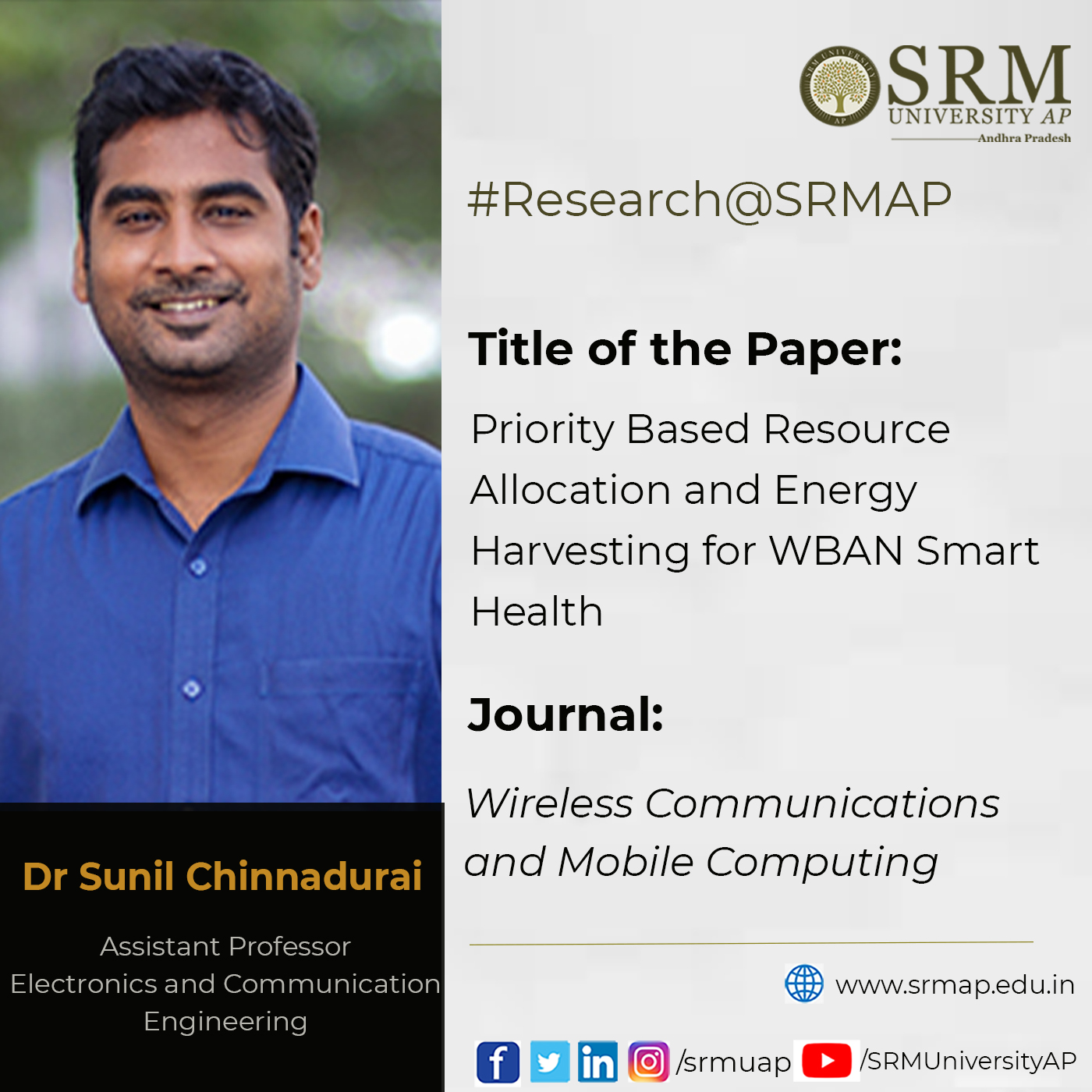 Integrated short-range wireless technologies are becoming the most sought-after machinery in recent years. The possibilities of its applications are expanding with the emergence of new health conditions and concerns. Assistant Professor of the Department of Electronics and Communication Engineering, Dr Sunil Chinnadurai’s recent research focuses on the future of this technology. His paper titled Priority Based Resource Allocation and Energy Harvesting for WBAN Smart Health got published in the journal Wireless Communications and Mobile Computing with Impact Factor 2.34. He worked with Dr Poongundran Selvaprabhu, Assistant Professor, Vellore Institute of Technology, for this project.
Integrated short-range wireless technologies are becoming the most sought-after machinery in recent years. The possibilities of its applications are expanding with the emergence of new health conditions and concerns. Assistant Professor of the Department of Electronics and Communication Engineering, Dr Sunil Chinnadurai’s recent research focuses on the future of this technology. His paper titled Priority Based Resource Allocation and Energy Harvesting for WBAN Smart Health got published in the journal Wireless Communications and Mobile Computing with Impact Factor 2.34. He worked with Dr Poongundran Selvaprabhu, Assistant Professor, Vellore Institute of Technology, for this project.Abstract
With the emergence of new viral infections and the rapid spread of chronic diseases in recent years, the demand for integrated short-range wireless technologies is becoming a major bottleneck. Implementation of advanced medical telemonitoring and telecare systems for on-body sensors needs frequent recharging or battery replacement. This paper discusses a priority-based resource allocation scheme and smart channel assignment in a wireless body area network capable of energy harvesting. The project investigates the researcher’s transmission scheme in regular communication, where the access point transmits energy and command while the sensor simultaneously sends the information to the access point. A priority schedule non-pre-emptive algorithm to keep the process running for all the users to achieve the maximum reliability of access by the decision-maker or hub during critical situations for users has been proposed. During an emergency or critical situation, the process does not stop until the decisionmaker, or the hub takes a final decision. The objective of the proposed scheme is to get all the user processes executed with minimum average waiting time and no starvation. By allocating a higher priority to emergencies and on data traffic signals such as critical and high-level signals, the proposed transmission scheme avoids inconsistent collisions. The results demonstrate that the proposed scheme significantly improves the quality of the network service in terms of data transmission for higher priority users.
Explanation of the research
A priority scheduling non-pre-emptive algorithm with SCA for WBAN smart health is proposed. The potential advantage of this algorithm is to keep on running the process for all users to attain maximum reliability until all the processes are executed. The data traffic associated with the priority scheduling non-pre-emptive algorithm is categorised into four major sub classes, namely, emergency, on-demand, normal, and non-medical data signals in order to assist the different QoS requirements. The results indicate that the priority scheduling non-pre-emptive algorithm performs during emergency and on-demand signals compared to the novel priority-based channel access algorithm for contention-based MAC (NPCA-MAC), low-rate wireless personal area networks (LR- WPAN), and priority-based adaptive schemes.
WBAN is a precise technology requiring frequent recharging or battery replacement. During the emergency or critical rescue situation, the highest priority user information is processed with minimum service delay without compromising the QoS. In addition, the proposed method prioritises the sensor nodes and classifies data traffic into emergency- (highest priority-), on-demand- (minimum priority-), normal (lowest priority-), and nonmedical- (normal-) based applications.
The future directions of WBAN are dealing with smart WBAN healthcare, trust management, trust negotiation, data security, uninterrupted lifetime, and intelligent decision-making (enhance the predictions from prior information) processes.
Continue reading → - Dual-Band 2×2 Elements MIMO Antenna-Diplexer July 27, 2022
Dr Divya Chaturvedi, Assistant Professor, from the Department of Electronics and Communication Engineering has been keenly pursuing research on wearable antennas that are used within the context of Wireless Body Area Networks. These antennas are commonly used in wearable wireless communication and bio-medical RF systems. Her latest publication “Design and Investigation of Dual-Band 2×2 Elements MIMO Antenna-Diplexer Based on Half-mode SIW” was featured in the Q1 journal, IEEE Access, having an Impact Factor of 3.37. The research was done in collaboration with Assistant Professor Dr Goutam Rana and Research Scholar Ms Buela Pramodini from the Department of Electronics and Communication Engineering.
This antenna is designed to enhance data rate twice as much as a single antenna. The antenna can be used to operate in two frequency bands simultaneously, without causing any interference. One frequency band can be used for the transmission of data while the other frequency band can be utilised for the reception of data. The radiating elements are configured in such a way that it occupies a compact size. Thus, the designed antenna can be easily mounted or integrated into a portable wireless electronic device. The field from one radiating element is not coupled to the other element due to their adequate isolation that mitigates the interference problem.
The dual-band self-diplexing 4-port MIMO antenna operates in the lower frequency band around 3.4 GHz (3.35-3.55 GHz, 160 MHz) for the TD-LTE system and in the higher frequency band around 4.2 GHz (4.14-4.34 GHz, 200 MHz) for FCC ID WLAN in 5G LTE communication. The electronic devices which operate in these frequency bands can enhance the data transmission and reception speed twice as much as a single element. In other words, the proposed design prototype also improves the reliability of communication by employing the spatial multiplexing technique. In future, they plan to work on the design and investigation of MIMO-based self-diplexing antenna using the polarization diversity technique.
Abstract of the Research
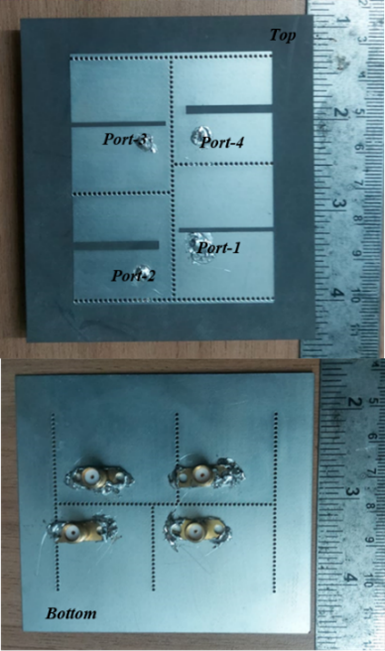
In this article, a compact dual-band, 2-elements antenna-diplexer is investigated and extended to a 2×2 multi-input and multi-output (MIMO) antenna. The proposed design employs half-mode Substrate Integrated Waveguide (HMSIW) technology, which reduces the antenna footprint by 50%. To enhance the bandwidth, a rectangular slot is engraved at the center of each HMSIW cavity. The slot splits the dominant mode of the HM cavity into two odd- and even-half TE110 modes in proximity, which leads to enhancement in the bandwidth by 50%. The antenna resonates around 3.4 GHz with a fractional bandwidth of 5% and around 4.3 GHz with a bandwidth of 4.7%, when corresponding ports are excited, respectively. Both the lower and upper frequency bands can be tuned individually, by simply altering the dimensions of each HMSIW cavity. This can be achieved in a common antenna, without employing filters, which satisfies the antenna-diplexer function. The isolation levels between any two radiating elements are obtained below -23 dB for the proposed MIMO antenna, and it occupies an overall size of 1.0λg × 0.8λg. The peak gain of the antenna is obtained at 5.35 dBi in the lower frequency band and at 6.75 dBi in the upper frequency band while radiation efficiency is better than 80% in both frequency bands.
- OMACS: the start-up initiative of Dr Udaya Shankar July 18, 2022
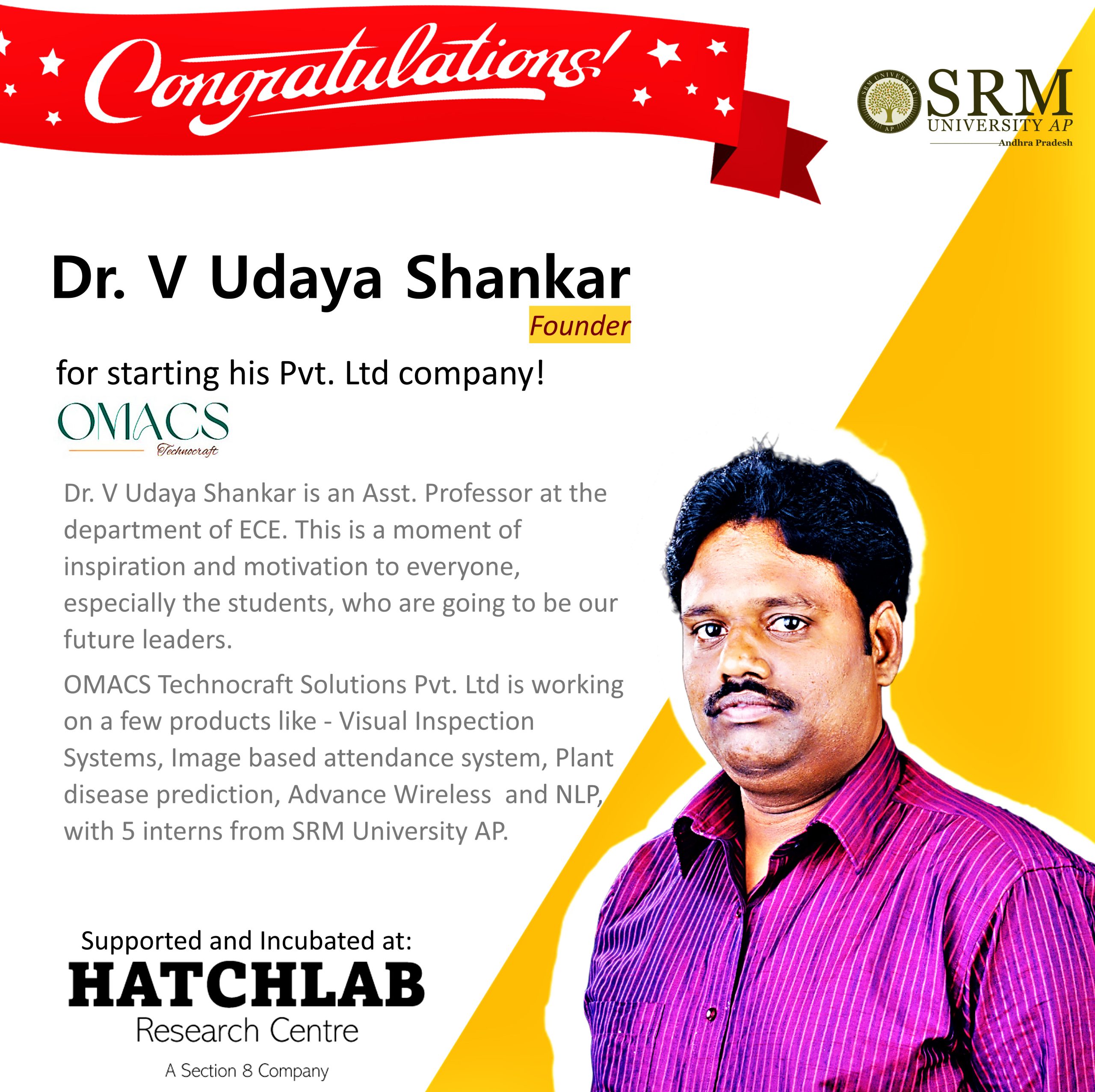 Start-ups are the centers of innovation. Ideas may seem easy, but their implementation is not. Dr Udaya Shankar from the Department of Electronics and Communication Engineering is ready to confront the challenges of innovation by registering his new start-up, OMACS.
Start-ups are the centers of innovation. Ideas may seem easy, but their implementation is not. Dr Udaya Shankar from the Department of Electronics and Communication Engineering is ready to confront the challenges of innovation by registering his new start-up, OMACS.OMACS envisions becoming the best research lab and product company within the next five years. The company’s motto is based on the 3P’s, that is, patents, papers, and product prototypes. The mission is to collaborate with world-class researchers experienced in both academy and industry. This will bring together the best advisors who have expertise in research and industry in the areas of AI and Game theory applications to Visual Inspection systems, 5G wireless communication networks, NFTs for Telecom, and Agriculture Robotics.
This company will be focused on developing products based on AI/ML-based visual inspection systems, Advanced wireless communications, NFTs for telecom, etc. Currently, five students from the university are interning with him and helping him develop the products.
Nine members are already being trained in the respected areas by enjoying their exposure to the industry environment. Four more interns are to be recruited for the ongoing projects. OMACS is in discussion with other start-up companies to offer research support to them. After six months of its implementation, the start-up plan to provide employment to some of the students in the university and recruit world-class people.
Mr Udayan Bakshi, Associate Director of Entrepreneurship, has helped him to initiate the start-up under the Hatchlab Incubation Centre of the university. “In every step of the journey of OMACS, we got all the support from Hatchlab. We are thankful to Hatchlab for their constant support and encouragement,” said Dr Udaya Shankar as he recollected the dynamics of Hatchlab and OMACS.
Click to visit the company website
Continue reading → - Reverse carry select adder and graphene-based field-effect transistor July 5, 2022
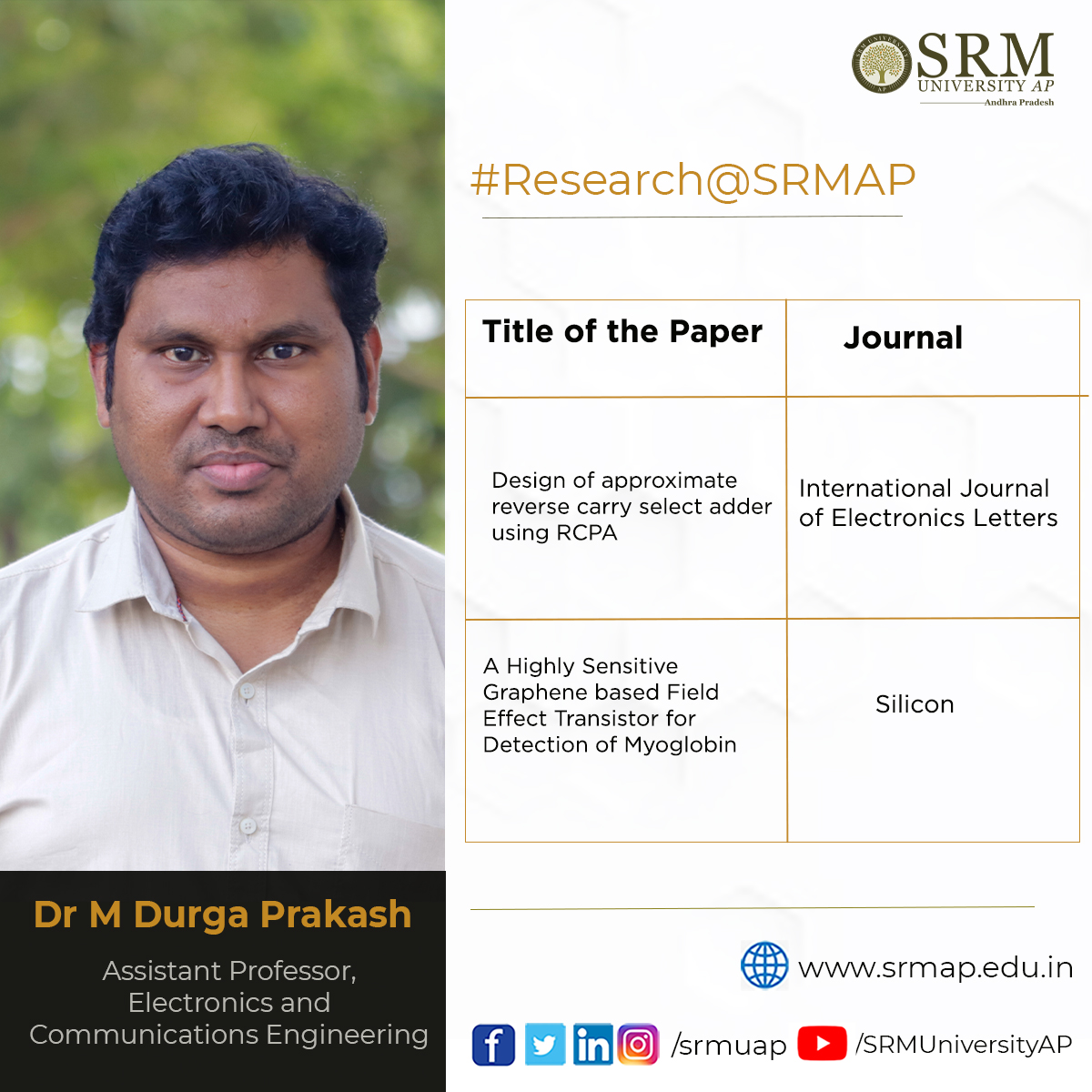 By publishing two papers in well-acclaimed research journals, Assistant Professor Dr M Durga Prakash of the Department of Electronics and Communication Engineering is expanding the possibilities of his research domain through innovative ideas. The first paper was published in the International Journal of Electronics Letters, an internationally renowned peer-reviewed rapid communication journal. It is titled Design of approximate reverse carry select adder using RCPA and has an impact factor of 1.5.
By publishing two papers in well-acclaimed research journals, Assistant Professor Dr M Durga Prakash of the Department of Electronics and Communication Engineering is expanding the possibilities of his research domain through innovative ideas. The first paper was published in the International Journal of Electronics Letters, an internationally renowned peer-reviewed rapid communication journal. It is titled Design of approximate reverse carry select adder using RCPA and has an impact factor of 1.5.Abstract
An approximate carry select adder (CSLA) with reverse carry propagation (RCSLA) is shown in this work. This RCSLA was designed with a reverse carry propagate full adder (RCPFA). In the RCPFA structure, the carry signal propagates in the reverse direction, that is, from MSB part to LSB part, then the carry input has greater importance compared to the output carry. Three types of implementations were designed in RCPFA based on the design parameters. This method was applied to RCA & CSLA to design other types of approximate adders. These designs and simulations were done in CADENCE Software tool with 45 nm COMS technology. The design parameters of the three CSLA implementations with RCPFA are compared with the existing CSLA adders.
The other paper, A highly sensitive graphene-based field-effect transistor for detection of myoglobin, has been published in the Silicon Journal, an international and interdisciplinary journal, with an impact factor of 2.67.
Abstract
Biomedical applications adapt Nanotechnology-based transistors as a key component in the biosensors for diagnosing life-threatening diseases like Covid-19, Acute Myocardial Infarction (AMI), etc. The proposed work introduces a new biosensor, based on the Graphene Field Effect Transistor (GFET), which is used in the diagnosis of Myoglobin (Mb) in human blood. Graphene-based biosensors are faster, more precise, stronger, and more trustworthy. A GFET is created in this study for the detection of myoglobin biomarker at various low concentrations. Because graphene is sensitive to a variety of biomarker materials, it can be employed as a gate material. When constructed Graphene FET is applied to myoglobin antigens, it has a significant response. The detection level for myoglobin is roughly 30 fg/ml, which is quite high. The electrical behaviour of the GFET-based biosensor in detecting myoglobin marker is ideal for Lab-on-Chip platforms and Cardiac Point-of-Care Diagnosis.
Continue reading → - Dr Sujith Kalluri elected as the Honorary Secretary of IETE, Vijayawada Chapter July 1, 2022
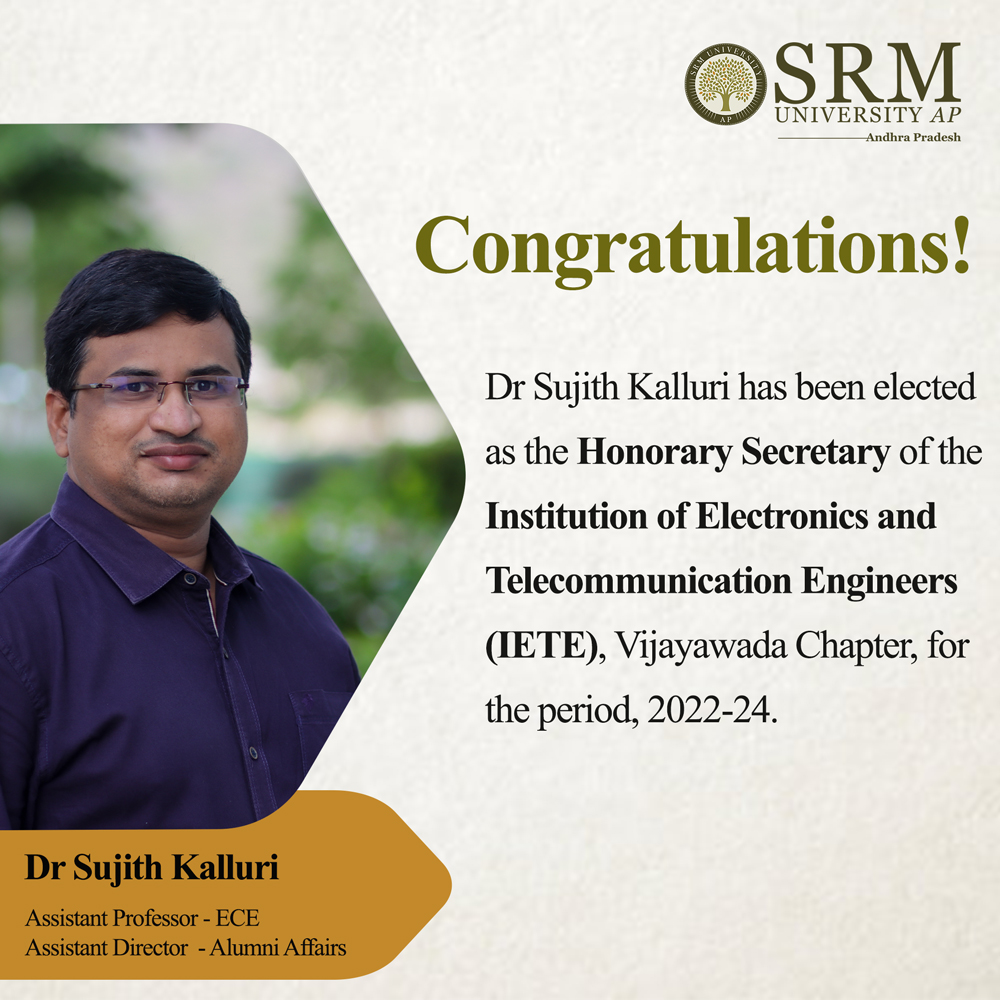
Dr Sujith Kalluri, Assistant Professor of the Department of Electronics and Communication Engineering, has been elected as the Honorary Secretary of the Institution of Electronics and Telecommunication Engineers (IETE), Vijayawada Chapter for the period, 2022-24. Dr Kalluri is one of the young and spirited faces of SRM University-AP who has already borne out his charisma and capacity as an influential teacher and passionate researcher. He is also the Assistant Director of Alumni Affairs, a forum that oversees and follows up on the activities of students graduating from the University.
SRM University-AP is proud and privileged to celebrate this achievement as Dr Kalluri is on a roll to make greater strides in his professional career. Being the youngest officer to assume the role of secretary at the office of IETE Vijayawada makes this even more special an accomplishment. “I am indeed privileged to assume the role of Honorary Secretary of the Institution of Electronics and Telecommunication Engineers (IETE) Vijayawada Chapter. This is an incredible opportunity to collaborate with various academic and industrial experts in relevant domains” he exclaimed.
IETE is India’s leading recognised professional society devoted to the advancement of Science and Technology in electronics, telecommunications and IT. The institution provides leadership in scientific and technical areas of direct importance to the national development and economy. The government of India has recognised IETE as a Scientific and Industrial Research Organisation (SIRO). Dr Kalluri intends to utilise this opportunity to conduct technical events, such as conferences, symposia, and exhibitions, that would benefit the student community to be industry ready and acquaint with different professional networking circles.
Dr Kalluri is an active member of the World Academic-Industry Research Collaboration Organization (WAIRCO), the Institute of Electrical and Electronics Engineers (IEEE), and the Australian Nanotechnology Network (ANN) among many others. “It is my passion to be associated with professional bodies. I take this as an exciting opportunity to build my leadership and organising skills that could facilitate my professional growth” remarked Dr Kalluri. “I would also like to convey my gratitude to the management and leadership teams at SRM University-AP who have always supported me in terms of availing such opportunities” he maintained.

